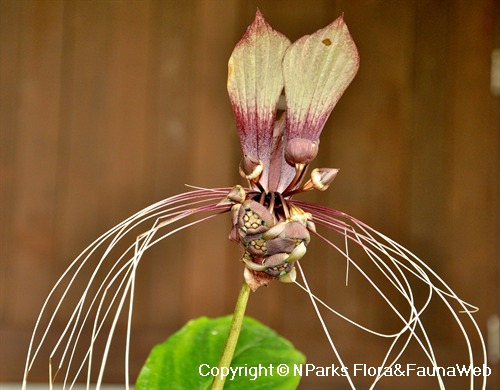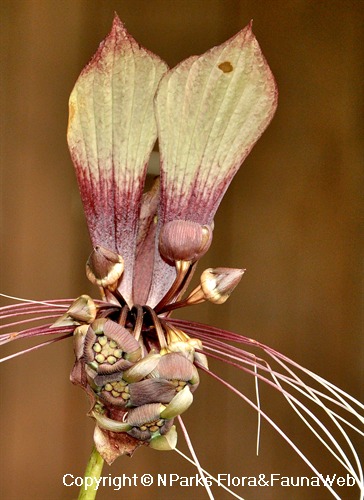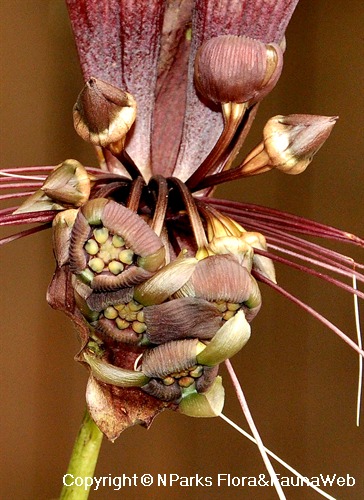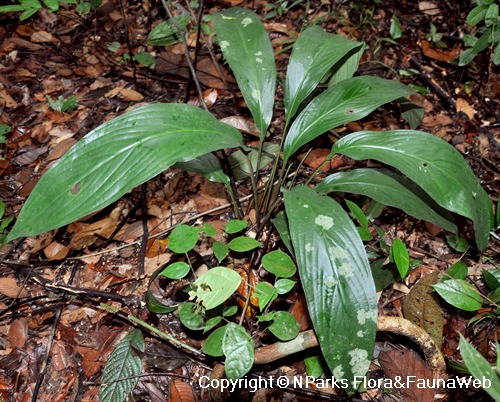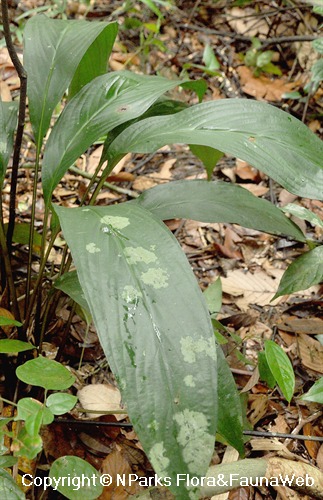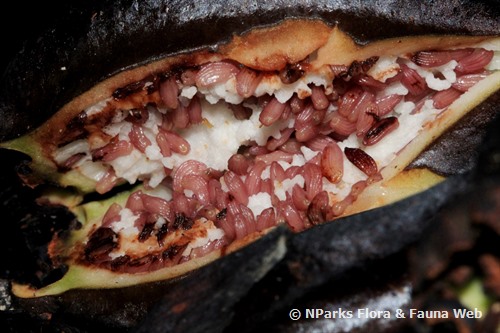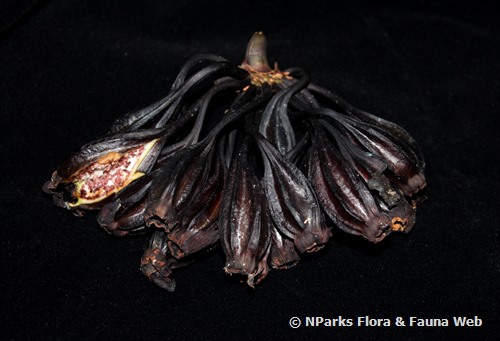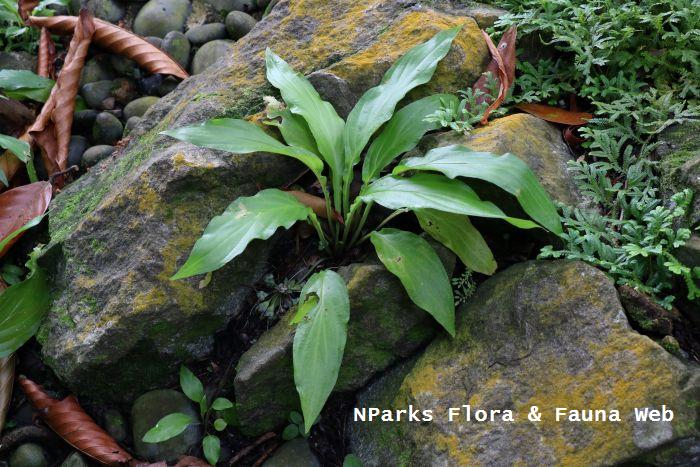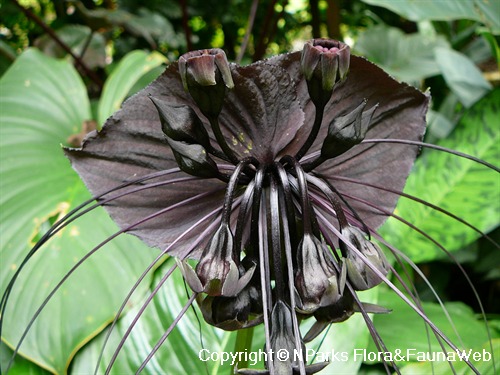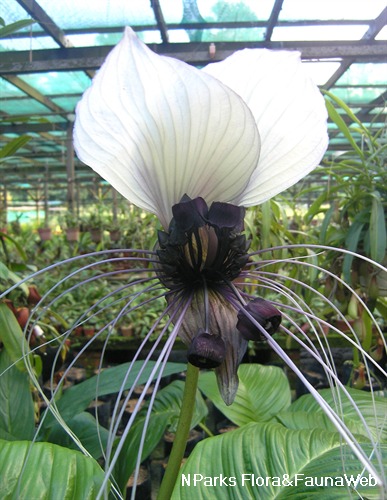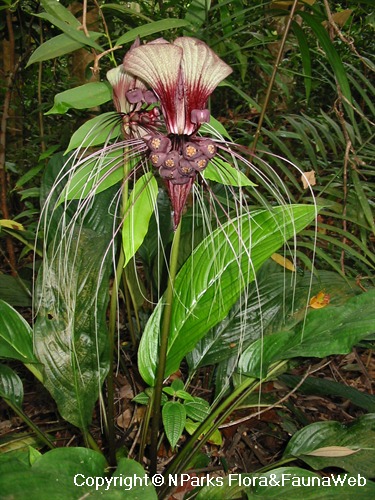
Back
Tacca cristata Jack
| Family Name: | Dioscoreaceae |
| Synonyms: | Ataccia cristata (Jack) Kunth |
| Common Name: | White Bat Lily, Bat Flower, Giant Bat Plant, White Bat Plant, Devil's Flower, Keladi Murai, Kelemoyang Air, Belimbing Tanah |
The White Bat Lily (Tacca cristata) is a shade-loving herbaceous plant that can be found in the forest understorey of Singapore and Peninsular Malaysia. It produces bizarre inflorescences with white, rabbit-ears-like bracts and long, whisker-like bracteoles. The unique flowers are pollinated by female midges and also exhibit self-pollination. Previously considered a synonym of T. integrifolia, it is now treated as its own species based on molecular data and morphology differences of the two species.
Name
Classifications and Characteristics
| Plant Division | Angiosperms (Flowering Seed Plants) (Monocotyledon) |
|---|---|
| Plant Growth Form | Herbaceous Plant |
| Lifespan (in Singapore) | Perennial |
| Mode of Nutrition | Autotrophic |
| Plant Shape | Irregular, Fountain (Palm-like) |
| Maximum Height | 0.6 m to 1 m |
| Maximum Plant Spread / Crown Width | 0.6 m to 0.9 m |
Biogeography
| Native Distribution | Peninsular Malaysia & Singapore |
|---|---|
| Native Habitat | Terrestrial (Primary Rainforest) |
| Preferred Climate Zone | Tropical |
| Local Conservation Status | Native to Singapore (Vulnerable (VU)) |
Description and Ethnobotany
| Growth Form | It is a perennial, rhizomatous herb that grows up to 1 m tall. |
|---|---|
| Foliage | The leaves are fleshy, narrow, decurrent to broadly lance-shaped, up to 40–65 cm long by 15–17 cm wide, with depressed veins. The upperside of the leaves is glossy and green, while the undersides are paler and matt. The petioles are D-shaped in cross-section, green with purple edges. The leaves are arranged in a rosette. |
| Stems | It has cylindrical rhizomes (thick, horizontal modified stems), usually underground, but can be visible as the plant ages. |
| Flowers | The inflorescence is an umbellate cymose, subtended by two pairs of involucral bracts: the outer pair is purple, ovate, and positioned sideways, and the inner showier pair resembles rabbit ears, being spathulate with a dark purple base, purple margin and veins, and pale-purple or purplish green in middle portion. The bracteoles are thread-like and reaching 17 cm long. Each flower has six greenish-purple to dark purple tepals (a term for petals and sepals), six purple stamens and a single tri-lobed stigma. Each flower is attached to a 2.4-3.4 cm long pedicel (a flower stalk). The inflorescences and flowers grow above the foliage. |
| Fruit | Its fruits are ribbed obpyramidal berries, 5 cm long by 2.5 cm wide, that ripened to dark brown to purple, and contain numerous brown, ovoid seeds. |
| Habitat | It grows in the understorey of lowland to lower hill moist to humid dipterocarp forest over granite. <2> It can be found locally along Seletar Track, in Nee Soon Swamp Forest, Bukit Batok, and Bukit Timah Nature Reserve. |
| Similar | Previously considered as the same species as T. integrifolia, the two species can be differentiated by the narrow, decurrent leaves and spathulate inner showy bracts of T. cristata vs. the oblong leaves and obovate inner showy bracts of T. integrifolia. Due to molecular and morphological differences, populations in Peninsular Malaysia and Singapore are now identified as T. cristata while those found in Northeastern India through Southwest China remain as T. integrifolia. |
| Associated Fauna | Its flowers are pollinated by female ceratopogonid midges but predominantly exhibit autogamy (self-pollination). In Singapore, various mammals were theorised to feed on the flowers and rhizomes, such as macaques, rodents, and wildboars. <1> |
| Taxonomy | The genus Tacca was previously classified in its own family (Taccaceae) but has now been subsumed into Dioscoreaceae under APG II (2003). This species was previously considered to be a synonym of T. integrifolia but is now treated as a distinct species, based on molecular data and morphological differences. <1 & 3> |
| Cultivation | It grows well in moist, shaded areas with moist but well-draining soil and plenty of organic material. It prefers high humidity due to its humid, understorey habitat. It can be propagated by seeds, rhizomes, or division. |
| Etymology | The genus Tacca is from a Malayan vernacular name, taka, 'arrowroot'. The specific epither cristata is Latin for 'crest' or 'comb.' |
| Ethnobotanical Uses | Cultural / Religious: Orang asli (arboriginal Malays) in Malaysia are said to avoid looking into the "eyes" of the inflorescence for fear of death. Due to its almost all-black inflorescences, plant also regarded as inauspicious by the superstitious. Others: The cut stems are bundled up, wrapped with leaves, and roasted to extract juice that is applied as poison to arrowheads. |
Landscaping Features
| Landscaping | It is suitable for shaded to partially-shaded, moist areas in parks and gardens. |
|---|---|
| Desirable Plant Features | Ornamental Flowers, Ornamental Foliage |
| Landscape Uses | General, Container Planting, Focal Plant, Parks & Gardens, Small Gardens, Interiorscape/ Indoor Plant |
| Thematic Landscaping | Naturalistic Garden |
| Usage Hazard - Cons | Toxic Upon Ingestion |
| Usage Hazard - Cons Remarks | Toxic if ingested: The plant contains taccalonolides and, while not known to be toxic to humans, may cause allergic reaction when ingested. It may be toxic to cats and dogs, so keep away from pets. |
| Plant & Rootzone Preference or Tolerance Remarks | pH 5.1 - 5.5 |
Fauna, Pollination and Dispersal
| Pollination Method(s) | Abiotic (Self-Pollinated), Biotic (Fauna) (Carrion Insects (Carrion Fly, Carrion Beetle)) |
|---|
Plant Care and Propagation
| Light Preference | Semi-Shade, Full Shade |
|---|---|
| Water Preference | Moderate Water, Occasional Misting |
| Plant Growth Rate | Moderate |
| Rootzone Tolerance | Fertile Loamy Soils, Well-Drained Soils, Acidic (low pH) Soils, Moist Soils |
| Maintenance Requirements | Moderate |
| Fertilizing | Use slow-release fertilizers. |
| Propagation Method | Seed, Storage Organ (Rhizome), Division |
Foliar
| Foliage Retention | Evergreen |
|---|---|
| Mature Foliage Colour(s) | Green |
| Mature Foliage Texture(s) | Smooth, Leathery, Glossy / Shiny, Raised / Sunken Veins |
| Foliar Type | Simple / Unifoliate |
| Foliar Arrangement Along Stem | Rosulate / Rosette |
| Foliar Attachment to Stem | Petiolate |
| Foliar Shape(s) | Non-Palm Foliage (Lanceolate, Elliptical) |
| Foliar Venation | Pinnate / Net |
| Foliar Margin | Entire |
| Foliar Apex - Tip | Acuminate |
| Foliar Base | Cuneate |
| Typical Foliar Area | Notophyll ( 20.25cm2 - 45 cm2 ) |
| Leaf Area Index (LAI) for Green Plot Ratio | 3.5 (Shrub & Groundcover - Monocot) |
Non - Foliar and Storage
| Stem Type & Modification | Herbaceous |
|---|---|
| Root Type | Underground (Fibrous Root) |
| Specialised Storage Organ(s) | Underground (Rhizome) |
Floral (Angiosperm)
| Flower & Plant Sexuality | Bisexual Flowers |
| Flower Colour(s) | Brown, Purple |
|---|---|
| Flower Grouping | Cluster / Inflorescence |
| Flower Location | Axillary |
| Flower Symmetry | Bilateral |
| Ovule Placentation | Parietal |
| Ovary Position | Inferior / Epipgynous |
| Flowering Habit | Polycarpic |
| Inflorescence Type Remarks | Umbellate cymose |
Fruit, Seed and Spore
| Mature Fruit Colour(s) | Black, Purple |
|---|---|
| Fruit Classification | Simple Fruit |
| Fruit Type | Fleshy Fruit , Berry |
References
| References | <1> Lim, G.S, & Raguso, R.A. (2017). Floral Visitation, Pollen Removal, and Pollen Transport of Tacca cristata Jack (Dioscoreaceae) by Female Ceratopogonid Midges (Diptera: Ceratopogonidae). International Journal of Plant Sciences., 178(5). <2> Wong, S.Y., & Chua, K.S. (2019). Phylogeny of Tacca (Taccaceae) and traits in reproductive structures, with description of a new Bornean species. Biodiversitas 20: 3096-3118. <3> Zhang, L., et. al. (2011). Phylogeny and evolution of bracts and bracteoles in Tacca (Dioscoreaceae). J. Integr. Plant Biol. 53(11): 901–911. |
|---|
Image Repository
Others
| Master ID | 1197 |
|---|---|
| Species ID | 2490 |
| Flora Disclaimer | The information in this website has been compiled from reliable sources, such as reference works on medicinal plants. It is not a substitute for medical advice or treatment and NParks does not purport to provide any medical advice. Readers should always consult his/her physician before using or consuming a plant for medicinal purposes. |

